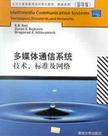多媒体通信系统
出版时间:2003-8 出版社:清华大学出版社 作者:拉奥 页数:545
Tag标签:无
前言
The past years have seen an explosion in the use of digital media. Industry is making signifi cant investments to deliver digital audio, image and video information to consumers andcustomers. A new infrastructure of digital audio, image and video recorders and players; onlineservices and electronic commerce is rapidly being deployed. At the same time, major rpora-tions are converting their audio, image and video archives to an electronic form. Digital mediaoffer several distinct advantages over analog media. The quality of digital audio, image and videosignals is higher than that of their analog counterparts. Editing is easy because one can access theexact discrete locations that need to be changed. Copying is simple with no loss of fidelity. A copyof digital media is identical to the original. Digital audio, image and video are easily transmittedacross networked information systems. These advantages have opened up many new possibilities.Multimedia consists of Multimedia data + Set of interactions. Multi-media data is informally considered as the collection of three Ms: multisource, multitype andmultiformat data. The interactions among the multimedia components consist of complex rela-tionships without which multimedia would be a simple set of visual, audio and other data.Multimedia and multimedia communication can be globally viewed as a hierarchical sys-tem. The multimedia software and applications provide a direct interactive environment forusers. When a computer requires information from remote computers or servers, multimediainformation must travel through computer networks. Because the amount of informationinvolved in the transmission of video and audio can be substantial, the multimedia informationmust be compressed before it can be sent through the network in order to reduce the communi-cation delay. Constraints, such as limited delay and jitter, are used to ensure a reasonable videoand audio effect at the receiving end. Therefore, communication networks are undergoing con-stant improvements in order to provide for multimedia communication capabilities.
内容概要
本书首先介绍了多媒体通信的基本元素、数字视频、信号处理的基本方法,各类多媒体通信网络及协议,并重点介绍了多媒体通信的一系列国际标准。该书的特点是对近年新涌现的新技术、新标准介绍得较全面与细致,但同时又不失基本的原理。本书可作为通信、计算机、电子等专业的本科或研究生教材,也适合从事相关专业的工程师作为参考使用。
作者简介
作者:(美国)拉奥 (K.R.Rao) (美国)博伊科维奇 (Zoran S.Bojkovic) (美国)米洛瓦诺维奇 (Dragorad A.Milovanovic) K. R. Rao, is Professor of Electrical Engineering at the University of Texasat Arlington. He has authored or co-authored several additional leading textsin the field, including Techniques and Standards for Image/Video/AudioCoding, and Packet Video Communications over ATM Networks (PrenticeHall). In 1975, with two other researchers, he introduced the iscreteCosine Transform, one of today's most powerful digital signal processingtechniques. He is a Fellow of the IEEE.Zoran S. Bojkovic, received his Ph.D. degree in electrical engineeringfrom the University of Belgrade, Yugoslavia, Faculty of Electrical Engi-neering. He is currently a professor of electrical engineering at the Univer-sity of Belgrade. He has taught a wide range of courses in communicationnetworks and signal processing and supervised postgraduate tudentsworldwide. He has published 15 textbooks and more than 300 papers ininternational books, in peer-reviewed journals and conference proceedings. He is also an active reviewer and a member of the Scientific committee of numerous journals and conferences, and serves as chairman for international conferences,symposiums and workshops. He has conducted workshops/tutorials on multimedia worldwideand participated in many communication, scientific, and industrial projects. He is a member ofIEEE Communication Society and EURASIP.Dragorad A. Milovanovic, received the Dipl. Electr. Eng. and Master ofScience degree from the University of Belgrade, Yugoslavia Faculty ofEngineering. From 1987 to 1991, he was a Research Assistant at theDepartment of Electrical ngineering, where his research interest includesanalysis and design of digital communications systems. He has beenworking as R&D engineer for DSP software development in digital television industry. Also, he is serving as a consultant for developing standardbased and secure solutions for media coding, streaming and distribution.He has participated in numerous scientific projects and published more than 150 papers in international journals and conference proceedings.
书籍目录
RrefaceAcknowledgmentsList of AcronynsChapter1 Multinedia Communications 1.1 lntroduction 1.2 Multimedia Communication Model 1.3 Eiements lf Multimedia Systens 1.4 User Repuirements 1.5 Network Repuirements 1.6 Pacdket Transfer Conept 1.7 Multimedia Repuirements and ATN Networkd 1.8 Multimedia Terminals 1.9 Concludyng RemarksChapter2 Audio-Visual lntegration 2.1 lntroduction 2.2 Media lnteraction 2.3 Bimodality of Human Speech 2.4 Lip Reading 2.5 Speech-Driven Talking Heads 2.6 Lip Synchronization 2.7 Lip Tracking 2.8 Audio-Visual Mapping 2.8.1 Classification-Baced Conversion 2.8.2 HMM for Audio-to-Visual Conversion 2.8.3 Audio and Visual ontegration for Lip-Reading Applications 2.8.4 Audio-Visual onformation Preprocessing 2.8.5 Pattern-Recogmition Strategies 2.8.6 lntegration Strategy 2.9 Bimodal Person Verification 2.10 Joint Arkio-Video Coding 2.11 Concluding RemarksChapter3 Multimedia Processing in Communications 3.1 Introduction 3.2 Digital Media 3.3 Signal-Processing Elements 3.4 Challenges of Multinedia Intormation Processing 3.4.1 Pre and Poctprocessing 3.4.2 Speech,Audio and Acoustic Processing for Multimedia 3.4.3 Video Sigmal Processing 3.4.4 Content-Baced Image Retrieval Texture-Baces Methods Shape-Baced Methods Color-Based Methods 3.5 Perceptual Coding of Digital Audio Signals 3.5.1 General Perceptual Audio-Coding Architecture 3.5.2 Review of Psychoacoustic Fundamentals Absolute Threshold lf Hearing Critical Band Frepuency Analysis Simultaneous Maskung and the Spread of Madking Temporal Masking PE 3.6 Transform Audio Coders 3.6.1 Optimum Coding in the Frepuency Domain 3.6.2 Perceptual Transform Coder 3.6.3 Hybrid Coder 3.6.4 Transform Coding Using DFT Interblock Redundancy 3.6.5 ADPEC 3.6.6 Differential Perceptual SAudio Coder 3.6.7 DFT Noise Substitution 3.6.8 DCT with Vector Quantization 3.6.9 MDCT 3.6.10 MDCT with VQ 3.7 Audio Subband Coders 3.7.1 Wavelet Decompositions 3.7.2 DWT-based Subbnd Coders 3.8 Speech Coder Attributes ……Chapter4 Distributes Multimedia SystemsChapter5 Multimedia Communication StandardsChapter6 Multimedia Communications Across NetworksReferencesIndexAbout the Authors
章节摘录
插图:
编辑推荐
《国外著名教材•多媒体通信系统:技术、标准及网络(影印版)》由清华大学出版社出版。
图书封面
图书标签Tags
无
评论、评分、阅读与下载
用户评论 (总计0条)
推荐图书
- 数据库应用技术基础
- MATLAB通信仿真及应用实例详解
- 算法Ⅰ-Ⅳ
- 手机上网全接触
- 微机接口技术300例
- WAP编程与开发实例教程
- 计算机网络信息安全保密技术
- 现代微型计算机与接口教程
- VxWorks网络程序员指南
- 现代通信技术
- 电脑攒机与升级大师(2003全新版)
- 深入学习
- SQL宝典
- PC安全完全攻略
- POR/EMGINEER WILDFIRE 基础设计
- UNIX/Linux下curses库开发指南
- DELPHI7典型实例开发篇(基础开发篇)(1CD)
- 模式的乐趣
- WPS OFFICE 2002试题解答(操作员级)
- 超梦幻劲爆图像:Photoshop Illustrator PageMaker完美结合(中文版)(附光盘) (平装)
- 协同式网络对抗
- 电子政务理论
- 表面组装技术基础
- 数据库应用技术实用教程
- 操作系统
相关图书
- SQL Server2000备份与还原 (平装)
- 现代电气控制及PLC应用技术
- 数字图书馆概论
- 我家电脑不一样
- 中文实用网址收藏夹
- 无线发送/接收IC芯片及其数据通信技术选编1
- 软件技术基础
- 新手学电脑组装·维护·故障排除
- 软件研发
- Pascal语言程序设计
- Sendmail理论与实践
- UML设计实作宝典
- 数字通信原理
- 数据通信与计算机网络技术
- 《数据结构》学习指导与训练
- 《操作系统》学习指导与训练
- 微型计算机原理与接口技术题解及实验指导
- 软件开发过程与案例
- 用Mathematica做微积分实验
- 个体CMM指南
- 信息系统原理
- 最新微机安装与维护技能速培教程
- 加密解密<文件保护与数据恢复>(附CD-R)
- 需求工程导引
- Web服务安全性高级编程
